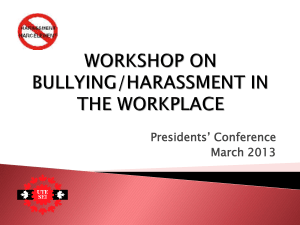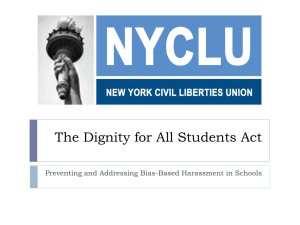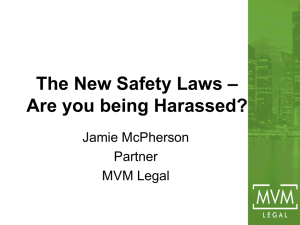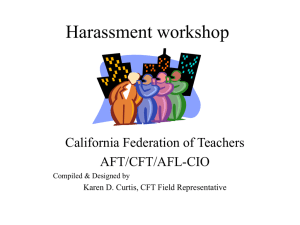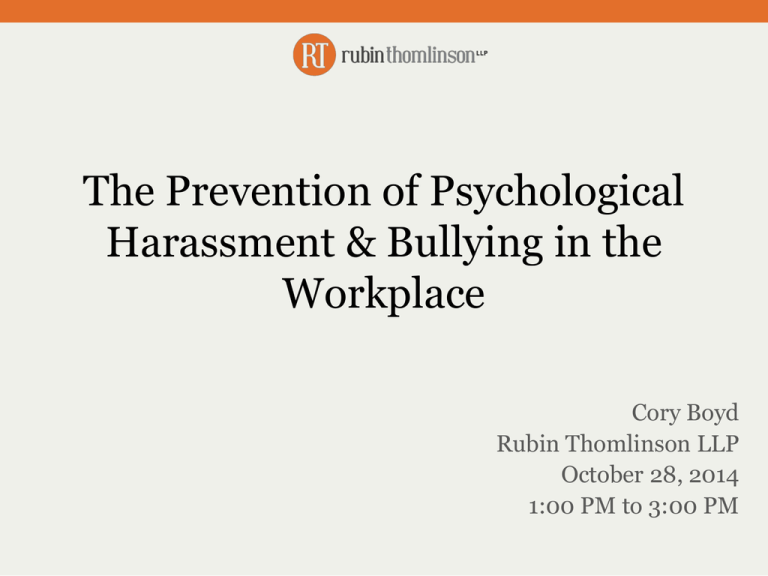
The Prevention of Psychological
Harassment & Bullying in the
Workplace
Cory Boyd
Rubin Thomlinson LLP
October 28, 2014
1:00 PM to 3:00 PM
Humber College’s Commitment
“The Humber College Institute of Technology &
Advanced Learning and the University of GuelphHumber (hereafter referred to as “Humber” or “the
College”) has the right, as well as the legal and
moral responsibility, to ensure that all its members
are treated fairly, equitably, and respectfully, in
order to provide a learning, living and working
environment that is free from discrimination and
harassment.”
Agenda
• Introduction
• What is Psychological Harassment?
• Relationship Between Psychological
Harassment/Bullying and the Ontario Human Rights
Code
• Identifying Psychological Harassment
• Scenarios
• Impact of Psychological Harassment on the Workplace
• Best Practices for Preventing Psychological Harassment
and Bullying
Two Types of Harassment:
• Harassment based on a “prohibited ground”
of discrimination (Code-based); and
• “Personal” (or psychological) harassment,
bullying or other workplace harassment that is
not based on a prohibited ground (non-Code)
Code-Based Harassment:
• “Harassment” means engaging in a course of
vexatious comment or conduct that is known or
ought reasonably to be known to be unwelcome
– Human Rights Code, R.S.O. 1990, CHAPTER
H.19
Prohibited Grounds:
1.
2.
3.
4.
5.
6.
7.
8.
9.
Race
Sex
Sexual Orientation
Disability
Age
Marital Status
Family Status
Place of Origin
Colour
10. Ethnic Origin
11. Citizenship
12. Creed/Religion
13. Record of Offences
14. Gender Identity
15. Gender Expression
16. Ancestry
17. Receipt of Public
Assistance
Psychological Harassment
“Workplace Harassment” means engaging in a
course of vexatious comment or conduct against a
worker in a workplace that is known or ought
reasonably to be known to be unwelcome
– Occupational Health and Safety Act,
R.S.O. 1990, CHAPTER O.1
Psychological Harassment (Cont’d)
Personal/Psychological Harassment: Behaviour in the
form of repeated and hostile or unwanted conduct, verbal
comments, actions or gestures, that affects an employee’s
dignity or psychological or physical integrity and that result
in a harmful work environment for the employee. It
includes and is not limited to behaviours defined
as bullying, mobbing, victimization, emotional
abuse, psychological abuse, and psychological
violence.
– Humber Human Rights Policy
Psychological Harassment (Cont’d)
A single serious incident of such behaviour that
has a lasting harmful effect may constitute
psychological harassment. It must be
demonstrated that this behaviour affects the
person’s dignity or physical or psychological
integrity and that it results in a harmful work
environment for the employee.
– Humber Human Rights Policy
Psychological Harassment (Cont’d)
Note: Harassment does not occur where a
supervisor gives legitimate directions or
instructions to an employee in the course of
employment or conducts performance reviews in
accordance with the college's normal procedures.
– Humber Human Rights Policy
Harassment Includes:
• Unwelcome remarks, jokes, slurs, innuendoes or
taunting;
• Hazing, stalking or shunning;
• The repeated mistreatment of one employee,
targeted by one or more employees with a
malicious mix of humiliation, intimidation and
sabotage of performance (bullying);
• Displaying derogatory or offensive pictures,
graffiti or materials either through printed copy
or personal computer;
Harassment Includes: (Cont’d)
• Verbal abuse;
• Insulting gestures or practical jokes which cause
embarrassment or awkwardness;
• Unauthorized and/or unnecessary physical
contact; and
• An impassioned, collective campaign by coworkers to exclude, punish and humiliate a
targeted worker.
– Humber Human Rights Policy
Psychological Harassment
May Include:
Shouting;
Use of profanity and abusive language;
Slamming doors;
Throwing objects;
Embarrassing, humiliating, degrading, demeaning,
or belittling another person;
• Name calling, persistent teasing where one person is
the object;
• Threats and intimidation;
•
•
•
•
•
Psychological Harassment
May Include: (Cont’d)
• Malicious gossip;
• Cyber bullying, negative blogging including
e-mails and Facebook postings;
• Retaliation;
• Bullying or shunning;
• Inappropriate use of progressive discipline to “get”
someone; and
• Blow-ups and eruptions at a person.
Misconceptions About Harassment
•
•
•
•
•
Requires intention
Can joke or comment about one’s own group
Must be ongoing
Silence = consent
Is only harassment if told to stop
Caselaw Review
• United Steelworkers of America, Local 9548 v.
Tenaris Algoma Tubes Inc, 2014 CanLII 26445 (ON
LA)
• Boucher v. Wal-Mart Canada Corp., 2014 ONCA
419 (CanLII)
• Ljuboja v. Aim Group Inc, 2013 CanLII 76529 (ON
LRB)
• Peterborough Regional Health Centre v. Ontario
Nurses' Assn. (Withers Grievance), 2012 CanLII
52238 (ON LA)
Caselaw Review
• Ontario Public Service Employees Union
(Marsh et al) v. Ontario (Community Safety
and Correctional Services), 2014 CanLII 13355
(ON GSB)
• Parsons v. Simcoe County District School
Board, 2012 CanLII 395 (ON LRB)
Scenario #1
Rajula is a hands-on manager with high
expectations. When she is unhappy with
someone’s work, she will often criticize their work
in front of other employees and clients. During
meetings, Rajula will take feedback from her high
performing employees but is very dismissive when
others speak. On one occasion, she told an
employee that until he can do his own job, she is
not interested in his thoughts on how she could do
hers.
Scenario #2
Marjorie recently returned to her position
following a maternity leave. Since her return,
whenever she has made a minor mistake at work,
her supervisor Eileen has told her not to worry as
she remembers what it’s like to have “Mom brain”.
Her supervisor also recently said to her that she
needed to be more precise in her communication
as she isn’t “talking to toddlers anymore”.
Scenario #3
Eric and Tamika both work as managers and both
are regularly asked to investigate misconduct.
They often disagree about an interpretation of the
Human Rights Code and do not always agree on
investigation findings. On one occasion, Tamika
spoke to one of the parties in an investigation
conducted by Eric and let him know that she
thought Eric had made a mistake. Eric heard she
also told a team of employees that they should
come to her with any complaints because she is the
only manager who knows what she’s doing.
Where is Psychological Harassment
Occurring?
Workplace Bullying Institute (2010 Study)
• 35% of workers have experienced bullying firsthand
• 62% of bullies are men; 58% of targets are women
• Women bullies target women in 80% of cases
• Bullying is 4X more prevalent than Code-based
harassment
• The majority (68%) of bullying is same-gender
harassment
Impact of Psychological Harassment
Workplace Bullying Institute (2012 Study)
The top 10 health problems from bullying, ranked from most to
least frequent, were:
1. Anticipation of next negative event
2. Overwhelming anxiety
3. Sleep disruption (hard to begin/too little)
4. Loss of concentration or memory
5. Uncontrollable mood swings
6. States of agitation or anger
7. Pervasive sadness
8. Heart palpitations
9. Insomnia
10. High blood pressure (hypertension)
Impact of Psychological Harassment
From an organizational perspective:
• Low morale
• High turnover
• Low productivity
• Lost innovation
• Hiring and enrolment challenges
• Financial costs
• Reputational
Signs of trouble:
•
•
•
•
•
•
•
Excessive absenteeism
Short-term or long-term disability
Decrease in productivity
Moodiness or erratic behaviour
Members of group isolated
Requests for transfer
Resignation
Addressing Psychological Harassment
– The Legal Requirement
Obligations under the Occupational Health and Safety Act:
• Create measures and procedures for workers to report
incidents of workplace harassment to the employer
or supervisor, which may include information about:
How, when and to whom a worker should report
incidents;
Forms or other reporting mechanisms; and
Roles and responsibilities of employers, supervisors,
workers and others in the incident reporting process.
Addressing Psychological Harassment
– The Legal Requirement
• Create measures and procedures for how the employer will
investigate and deal with incidents and complaints of
workplace harassment, which may include information about:
How and when investigations will be conducted;
What will be included in the investigation;
Roles and responsibilities of employers, supervisors, workers
and others;
Follow-up to the investigation (description of actions and
timeframe); and
Recordkeeping requirements.
Beware:
• The “under-response”
• Making assumptions about what really
happened
• Allowing knowledge of people involved to affect
action taken
Organizational Best Practices for
Preventing Psychological
Harassment and Bullying
•
•
•
•
Strong commitment from the top
Educate staff and students
Empower victims to come forward
Develop a strong compliance framework
Organizational Best Practices for
Preventing Psychological
Harassment and Bullying
• Ensure leaders model appropriate behaviour
• Investigate complaints
• Assume the allegations are true and ask the
threshold question
• Implement recommendations
• Restorative interventions – coaching and
counseling
What Can I Do?
•
•
•
•
•
•
Educate yourself
See something, say something
Avoid gossip and office politics
Do not minimize behaviour
Be an advocate
Communicate respectfully
Create a Culture of Respectful
Communication
• Recognition: Thanking employees and co-workers
and acknowledging their contributions on a daily basis.
• Empowerment: Providing employees with the tools,
resources, training, and information they need to be
successful; sharing these tools with co-workers.
• Supportive feedback: Giving ongoing performance
feedback — both positive and corrective.
• Partnering: Fostering a collaborative working
environment.
Create a Culture of Respectful
Communication
• Expectation setting: Establishing clear
expectations and holding employees accountable.
• Consideration: Demonstrating thoughtfulness,
empathy, and kindness.
• Trust: Demonstrating faith and belief in colleagues’
skills, abilities, and decisions.
– Paul Marciano, Carrots and Sticks Don’t Work:
Build a Culture of Employee Engagement with
the Principles of RESPECT
Questions?




